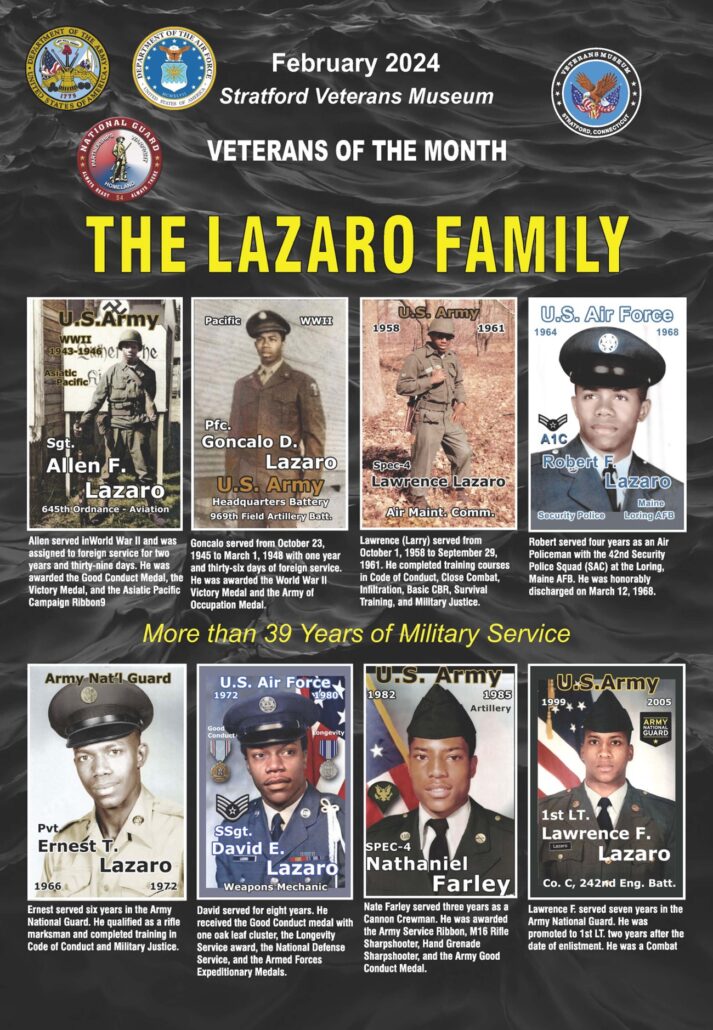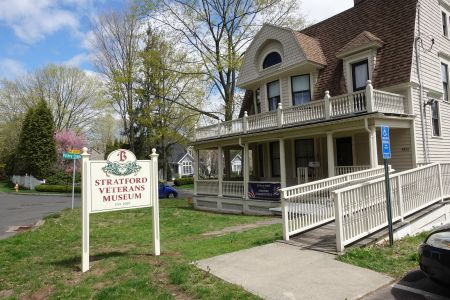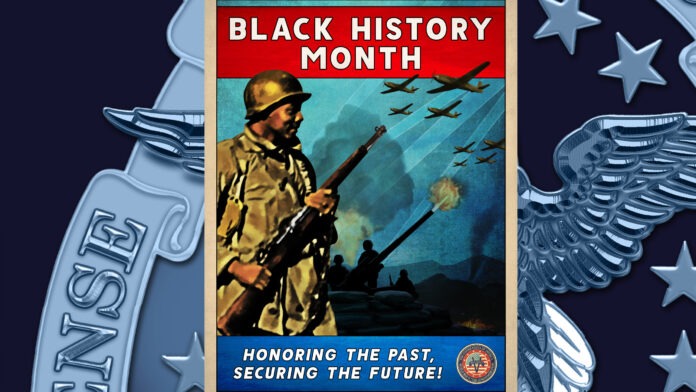David Lazaro, Staff Sergaent, U.S. Air Force Interview
Members of Stratford’s Lazaro family have 39 cumulative years of service in our nation’s Armed Forces between them, from World War II to the present.

The Stratford Veterans Museum is dedicated to telling the stories of the town’s men and women who have served their country through the Armed Forces. Part of the way that story is told is through a series of displays in the museum, including a “core” exhibit that takes visitors from the Revolutionary War through today’s conflicts.
The Museum, which was founded in 2020, is in the process of collecting information on our town’s veterans: any men or women who served in the Armed Forces, were honorably discharged, and are (or were) residents of Stratford. They interview our town’s veterans (and their relatives) to get their stories. If you would like to schedule an interview, please email svm5952@gmail.com.
David Lazaro, Staff Sergeant, U.S. Air Force Transcript
Crew Chief, Weapons Mechanic
I attended Stony Brook School, Worcester Junior High School, and then went on to Bunnell, where I played football and basketball. After Bunnell, I went to what was a small electro-mechanical drafting school on Main Street called Chester Institute, which is now part of Chester Porter technical school. I was there when I got my draft notice. So I went down to the Army and I sat down with the guy. He sent me to take the test and I came back and I guess he blew a lot of smoke in my ear, and he thought, oh well, we could have you as a warrant officer and everything, you know, and I said well okay—it’s interesting. So I left, went back to school and maybe about a month or two later I actually got my number. It was 80-something. That year in the draft they only actually went up to about a hundred, and I was the last group to get drafted.
So I go back down to the recruiter and the recruiter says, well Mr. Lazaro, you got your draft number, so all we got for you is basic training in Vietnam, and I said oh no!
So I was coming out of the recruiter’s office, walking down the main street in Bridgeport and another Air Force gentleman was walking up and he stopped and he said, man, you got to have the saddest face I’ve seen in a long time. He said, you got a minute tell me what’s wrong and I said, well I went in there to the Army. They had offered me all this other stuff before, and now that I got my draft notice they told me that they had nothing for me but basic training in Vietnam.
So he said to me, l tell you what, come back in with me and if you’re willing to do four years over two years, maybe I could help you out. So I went in there with him and he said, well, I’m gonna give you two tickets. You run up to New Haven to the Atheist building and you take the test for the Air Force, and then you get back on the train and by the time you get back I should know your score. So when I got back he said, well, everything worked fine, your scores were pretty good—one that put you in the Air Force, he said, but give me a couple days to work out a little bit of red tape with the Army and I’ll get back with you.
He called me back a couple days later. I came in, and at the time I still had two months to go to finish the drafting school I was going to. So he said to me, here’s what I’ll do. I’ll give you two months to finish school, one month to sow your oats, and then see me here and you’ll be off to Lackland Air Force Base.
I flew out of Bradley and down to Texas and went to Lackland AFB, did the regular basic training, which at the time wasn’t that bad, you know, because after you practice with Manning Harvey for a little while you’re in pretty good shape.
They said I was going to be, at the time they called it aircraft weapons mechanic, so I said okay. I knew nothing about it. We stayed in Texas just about two weeks and then they sent us to Denver, Colorado, where we did our schooling for weapons mechanic. We were there for about eight months, and then after we completed that they told me, well we are sending you to California, George Air Force Base, which is now closed down.
We went there to do OJT (on the job training). I got to a place called Victorville—a little horse and buggy town. When we pulled in I was waiting for a stage coach to come up or something, that’s how it was in the middle of this desert. At George, where we did our training on the aircraft, the F4 at the time, we did about eight months. They also had pilot training, so we were learning how to load and take care of the launchers and low missiles, and the pilots were learning how to drop them.
I was out there for about eight months and then I got regular Duty. We got assignments. There were sixteen of us. This is the interesting part—I’ll never forget this. I think this comes from having a praying mother and praying grandfather, because there were sixteen of us that were in the training program at the time for a weapons mechanic and the orders came down — out of the sixteen, fourteen went to Southeast Asia, and two individuals, me and one other guy, went to Korea, and the funny part is the other gentleman was from Rocky Hill. Out of all the training crew, the two Connecticut people both went to Korea. I looked at him and he said, man, somebody in the assignments must be from Connecticut, saw the old “40” and said, let me get these two homeboys a break. And so we went over to Korea. I was over there about four months.
Where we were trained it was cold, it’s very cold, and I would think at night that my father, he was in the Army and he was there like 40 years ago. He got out of military just before the Korean War. He got out of the army, and I would look and see them old Quonset huts. I had to say, man, how did he do it, you know, because it was rough to me, and we had nice barracks, you know, pretty good anyway. All of a sudden they came to us and they said, we need some guys to go to Hawaii because they rotate the planes every year. So the planes will leave Korea, fly to Hawaii, service them up and come to the states, and then planes from the states will go to Hawaii and then to Korea.
I got back to Korea. It was me and one other gentleman that was from New York, and we get into our shop, the weapon shop, and there’s nobody there. We’re walking around, we go to the first sergeant and said, hey, sorry where is everybody? He said, while you guys were on leave they activated your squadron to go to Taiwan, and the Squadron that was there went on to Thailand, and we took over their job to fly the border of Taiwan.
They gave us the tickets and we took a civilian plane to Japan, then from Japan we went over to Taiwan, and when we got to Taiwan we’re on the bus and a master sergeant said welcome to the best kept secret of the Orient. I was like whoa! So we got off, and the place was beautiful, the base was beautiful, and I was there for another nine months, and one month. I was just living downtown. I didn’t have to be on the base because they were rotating the planes that were there back to Guam, but because I was one month from my tour they allowed me to stay there until I got my assignment.
I chose California and went back to George AFB, and while I was at George there was a lot of whispers like, ‘hey they got a new aircraft coming out at 15’, and I said, oh wow, what does that look like, and I saw a picture of it. The guy said if you put in for that you’ll probably get it, because, you know, they’ll take all the weapon mechanics that they need because they’re trying to develop the program for the aircraft, so I said okay.
I was just about ready to re-enlist, so I put in for Langley where the first attack Fighter Wing was just starting, and so we were kind of the test crews to work out how we’re going to load this aircraft.
The F4 is low and you’re crawling around on your knees, but the F-15 you can almost just bend over and walk under it, so they decided to make three-man crews. On the F4 you had four man crews so it all got worked out, and the thing about it was we got to go to several other bases throughout the state because everybody wanted to see this new aircraft. They sent us to Florida, they sent us to Nellis AFB (Las Vegas). The Navy has Top Gun, the Air Force had Red Flag where they flew. They took us there and the F-15 just showed up.
Being at Langley in Virginia, I was able to run up and down the highway, back to Connecticut and back to Virginia Beach. I was there at Langley for four years in which time I made staff sergeant, and I have my own crew, and they had us out on the flight line doing combat quick turns — that’s when the plane just touches down, engines running and everything, and you’re running, and you’re jumping on the plane putting weapons, bombs and missiles and loading the gun while the plane is hot, and the pilot’s in there. At first it was a little nerve-wracking, but you know you’re doing something that your country needs, and you put your all into it. It turned out we had the best time on the combat quick turn on the F-15. This was 1977.
It was really interesting duty. We got hazardous duty pay every day we had to go out there and load missiles and things, but it was interesting. It got me to see quite a bit and I really enjoyed it, and as for my crew: one was from Virginia and I still hear from him, and I contact him every now and then. And the other one, I know he’s down in Georgia. I don’t see him too often, but it was a great experience.
If I had a chance to do it all over again, I definitely would. I got pictures at home in my garage, you know all my stuff from the Air Force, and the funny thing is the F-15— although I was on the F4 for about four years, it was not bad duty, but the F-15—I just fell in love with that plane, it was something else.
Around the early 70s they changed the listing as Armament Systems Mechanic, and I knew I couldn’t do that for TWA or nothing like that when I’m ready to get out, so I went in. I wanted to be a machinist. When I went in there the sergeant told me, well, I’m sorry, he said, you’re a staff sergeant with prior experience and we’re short on weapons mechanics, so you’re gonna have to stay with Weapons Mechanical Armament systems mechanic. Like I said, I put in for an assignment and got to Langley—it all worked out good.
Q: How did you keep in contact with your family while you were in for eight years?
That’s a good thing. My mom would write me and I would write her. Never heard a word from my father, he never wrote. My mother would put at the bottom of the letter, “your father says hello”. This is while I was at George Air Force Base. So when I got my assignment and they sent me to Korea, I guess that stirred up something in my father because he was stationed over there. I was getting letters every week — go see this, do they still have this? You know, and I was like, wow, he must be really reminiscing. He wrote me the day I left Korea. I didn’t get another letter, all I got was “your father says hello”. It was something. I still have those letters today.
For the full video go to: https://www.youtube.com/watch?v=ocNS-yawlKc
Members of Stratford’s own Lazaro family have 39 cumulative years of service in our nation’s Armed Forces between them, from World War II to the present.


